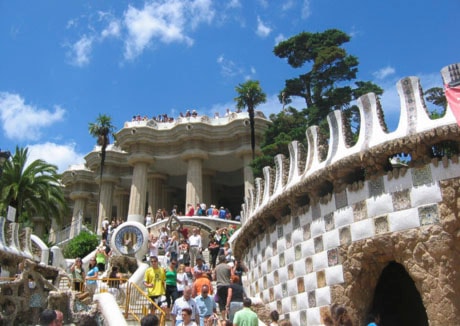FIGUERES, Spain — “That is a bit exaggerated, no,” wondered Corneel wide-eyed, as he walked through Salvador Dali’s magic kingdom, also known as Teatre-Museu Dali.
Unbound imagination is supposed to be the realm of tender teenagers like my son. So when even they cannot quite fathom the folly of an aging artist, it must be something to behold.
Golden eggs on top of a claret-coloured wedding cake palace were one thing. Add diamond-studded rings with a beating heart and an oversized statue of a chained opulent woman on top of a classic old car, and the viewer may be baffled. Love it, loathe it, it leaves no one indifferent. Dali truly took surrealism to unmatched heights and became one of the 20th century’s most prominent artists.
And to think Dali is not even the only “mad artist” to be found in this sun-and-sea-kissed region of Spain. Some 145 km from Figueres, in Barcelona, the architect Antoni Gaudi invented dragons covered in clipped, glazed tiles, and had visions of churches and spires so otherworldly and monumental that builders are still finishing his defining work today, more than a century after it started.
Bundled within one easy vacation in Catalonia, Dali and Gaudi pack a peculiar one-two cultural punch that resonates with adults and youngsters alike.
Bored kids and teenagers can tug at parents when they are forced to ponder the austere power of Romanesque cloisters or the inner light of yet another Renaissance Virgin and Child. Rarely is beauty for one so intertwined with boredom for the other. In comparison, the Dali and Gaudi sites of Catalonia can foster a cultural awakening for both generations.
And where better to start than in Figueres. In high season here, lines heading into the Teatre-Museu snake around several corners of the inner city, with shops hawking Dali merchandise, from purses resembling pink pouty lips to puzzles of his most outrageous paintings.
Even before entering the Dali palace, the line of visitors passes a huge golden faceless statue with reliefs and busts protruding from a robed chest. Looking down from the museum’s facade are men in diving gear and graceful figures bearing objects that resemble golden baguettes or fluffy clouds.
Sometimes museum-goers can benefit from explanations about what they’re viewing. But with Dali, there’s nothing better than just to take it in. How could anyone fully explain an installation called “Face of Mae West Which Can Be Used as an Apartment”?
His Teatre-Museu, the self-proclaimed “largest surrealistic object in the world,” has become one of the most visited museums in Spain. About 40 kilometres away, his labyrinthine home in Portlligat gives a more intimate look at the artist extraordinaire. Portlligat is located near Cadaques, a pristine white village set against the azure-coloured Mediterranean, where Dali spent summers in his youth.
For the Gaudi sites, head to Barcelona. Gaudi’s Sagrada Familia is a massive church that gives any visitor the rare thrill of experiencing a great work of art in progress.
Hulking cranes move material overhead, hammers cluck away and workers painstakingly massage Gaudi’s chipped, shiny tiles into the pillars and roofs. Lifts take you up in two spires, and the view from within is as spectacular as the view of Barcelona outside.
Some spires have yet to be built while others already show the patina of age. A recently finished side aisle feels like a walk through giant trees, testimony to Gaudi’s skill in turning a cold structure into almost an organic being.
Gaudi’s most pleasant, relaxing work is Parc Guell. It’s Gaudi at his quirkiest, unbound by religious convention, and even in summer, when the heat in Barcelona can be oppressive, the trees of the inner city park has shade to spare.
The park is also another way to introduce youngsters to a great artist. Young and old can lounge in the curving, tiled seats high up, enjoying the fairy-tale turrets and the blue of the ocean beyond.
Gaudi also built spectacular blocs of apartments in Barcelona. The chimneys and roof of La Pedrera evoke huge dollops of whipped cream with masks worked in. Look at Casa Batllo and see skulls and bones in the balconies.
Together, these Dali and Gaudi treasures make a compelling itinerary. And for travelling families especially, they offer a chance for the generations to share the wonder.
If you go ...
SALVADOR DALI: http://www.salvador-dali.org/museus/ (click English link at top). Teatre-Museu Dali in Figueres, Spain, and Casa-Museu Salvador Dali in Portlligat, Spain.
ANTONI GAUDI: http://www.seebarcelona.com/gaudi.htm. Sagrada Familia, http://www.sagradafamilia.cat/
